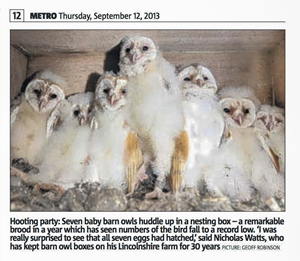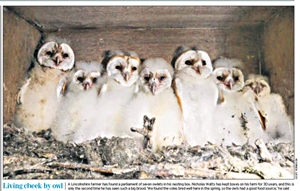 A farmer was amazed to find a rare brood of SEVEN baby BARN OWLS in his nesting box – in a year which has seen numbers of the bird drop to a record low.
A farmer was amazed to find a rare brood of SEVEN baby BARN OWLS in his nesting box – in a year which has seen numbers of the bird drop to a record low.
Nicholas Watts has had barn owl boxes on his farm in Lincolnshire for the last 30 years and visited more than 250 nests, but this is only the SECOND time he has seen such a big brood.
“I was really surprised to see that all seven eggs had hatched and the mother had reared all of them,” said Nicholas, 70, of Vine House Farm in Spalding. “The year started off badly for our Barn Owls and in May we had just three pairs breeding, but we found the voles bred well here in the spring, so the owls had a good food source. We now have nine pairs that have bred on the farm.”
The baby Barn Owls are now between four and six weeks old and will leave the nest, which is on a pole 12ft in the air, in around three weeks. Experts say the large brood is “absolutely remarkable” in what they say has been the WORST year ever for Barn Owls, with just 12 PER CENT of normal nest occupancy. They say Barn Owl numbers have reached an all-time low, following a run of record-breaking cold winters and springs and wet summers.

“A brood of seven Barn Owls is rare and I have only seen two in the last 23 years,” said David Ramsden, senior conservation officer at charity The Barn Owl Trust, based in Devon. “It is absolutely remarkable to have such a large brood this summer as barn owls are having a catastrophic year, in fact the worst they have ever had. You normally see a peak in mortality in the autumn and late winter, but the cold spring meant the mortality rate continued to go up and up, so we lost more birds than normal. It means that this summer there have been far less owls to breed and many that have survived are single or pairs that simply haven’t bred.”
He said many Barn Owls that had bred had been two months later than normal and a lot had been unsuccessful.
“The typical number of young in a brood is three but this year it has been an average of just 1.2. I don’t remember another year that has been this bad,” he said. “At the end of spring there were less Barn Owls in Britain than there have ever been before. A nest of seven owls means they must have found a good local food source. Sadly it is a blip in a bad year. The bigger picture is that this year has been appalling for Barn Owls.”
He said the very cold winters and springs and wet summers from 2009 onwards were to blame for the dramatic decline.
“We need a break from record weather and just need average seasons for a few years so the numbers of Barn Owls can recover,” he added. “We have had so few young this year that next year is not likely to be any better. Climate change is the root cause of this.”

Barn Owls have a distinctive white heart-shaped face, with a wing span of 85cm. They are fully grown from just 10 weeks old and stand 25cm tall. They shriek and hiss, rather than hoot, and hunt from the air. They tend to forage over any open habitat that supports a population of small mammals. Their soft feathers are not very waterproof so rain can be a problem and they also have difficulty hunting in high winds. A survey in the late 90’s showed there were around 4,000 pairs of Barn Owls in Britain, but this number is believed to have seriously declined.
Mr Ramsden said people could help save the Barn Owl by leaving areas of rough grassland and putting up nesting boxes.



